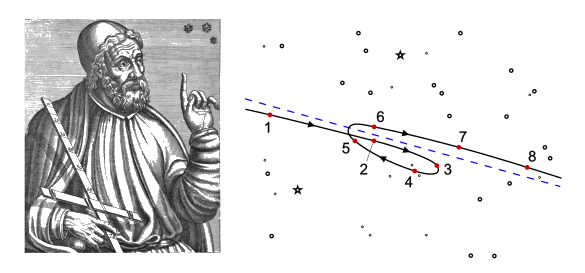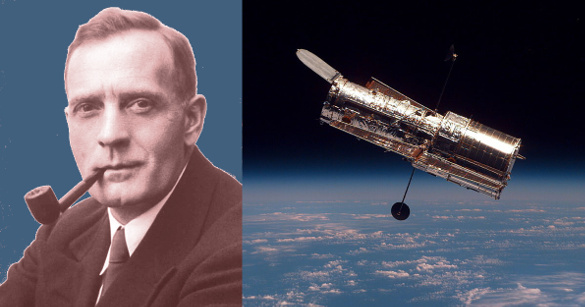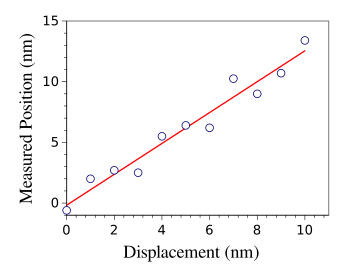Optical Ruler
August 5, 2019
I once read a
parody about how
science is usually done. It imagined how
scientific papers would have been written in the age of
Ptolemaic astronomy; that is, the
cosmological model that had
Earth as the center of the
Solar System. Since
planets sometimes move in
retrograde fashion, and not in a
uniform circular orbit around the Earth,
Alexandrian astronomer,
Ptolemy (c.100-c.170), proposed an explanation. In his
Almagest, Ptolemy explained that the planets spun on additional
spheres attached to their primary orbital sphere centered on Earth, creating
epicycles.
While one additional sphere explained most of the retrograde motion, this single epicycle still left some motions unexplained. In a solution that would appall
William of Ockham (c. 1287–1347), it was proposed that the planets are carried by a third sphere carried on this second sphere. In the parody, more refined measurements would require further spheres, and we would get papers entitled, "A nine epicycle fit to the orbit of
Mars." The proper solution to the problem of retrograde motion was the
heliocentric Copernican system.

Ptolemy (c.100-c.170) and the retrograde motion of Mars. The position of Mars is shown for monthly intervals with the ecliptic marked by the dashed blue line. (Ptolemy image from Les vrais pourtraits et vies des hommes illustres grecz, latins..., Blanche Marantin and Guillaume Chaudiere Publishers (Paris, 1584), via Wikimedia Commons. Apparent retrograde motion figure by M.L. Watts, taken from data in Thomas S. Kuhn, La rivoluzione copernicana (The Copernican Revolution), (Einaudi, Torino:2000), p. 63., via
Wikimedia Commons (modified). Click for larger image.)
This example illustrates how
measurement is an important part of science. Accurate measurements of planetary motion demonstrated how a once popular scientific model lacked
predictive accuracy, and this led to the Copernican Revolution. While
astronomers at those times could measure motions in
reference to the
fixed stars, motion in the
laboratory is measured with a
ruler, and this ruler can take forms quite different from marks on a
wooden or
metal slat.
Lengths are measured in relation to some length reference. In the past, when measurements were not that critical, the reference was as crude as a the
cubit, the length of a person's
forearm, and the
barleycorn, the length of which was supposed to be a third of an
inch. At the end of the
18th century, the
meter was defined as one ten-millionth of the distance from the
equator to the
North Pole, which makes for an unwieldy
calibration unit. The meter was re-defined in 1799 as the length of a
physical object, the
prototype meter, a
cylinder of
platinum-
iridium alloy, maintained at the
Bureau International des Poids et Mesures (International Bureau of Weights and Measures) outside
Paris.
As science progressed, so did the accuracy of the meter. In 1960, it was redefined as equal to 1,650,763.73
wavelengths of the orange-red
emission line of
krypton-86. In 1983, the length of the meter was redefined as the length of the path traveled by
light in
vacuum during a time interval of 1/299792458 of a
second. This redefinition was possible, since the speed of light in vacuum was fixed at exactly 299,792,458
meters per second; or, as I use it in most calculations, 300,000,000 meters per second.
Marks on a meter stick are useful for length measurement in most laboratories and
machine shops, but astronomers needed to work for years to establish
distance measurement to
stars,
galaxies, and
other objects of cosmological significance. Measurement of the distance to objects as distant as 13 billion
light years has been enabled by
Hubble's law and the
redshift caused by the
expansion of the universe.

Left, Edwin Hubble (1889-1953) in a 1931 portrait by Johan Hagemeyer (1884-1962); and, right, a photograph of the Hubble Space Telescope named after him. While Hubble didn't discover universal expansion, he did quantify the expansion in Hubble's law. In particular, American astronomer, Vesto Slipher (1875-1969), noticed high galactic redshifts a decade before publication of Hubble's Law. (Left image (modified) and right image via Wikimedia Commons. Click for larger image.)
At the opposite side of the length scale, in the realm of
nanotechnology, our ability to measure is constrained by our ability to see, and the
wavelength λ of
radiation imposes a limit to sight.
Resolving power is typically limited to about half the wavelength of the radiation. That's why
X-rays with tenth nanometer wavelength are used in
X-ray diffraction of crystals in which the
atomic spacing is of the order of a nanometer.
Scientists at
Nanyang Technological University (Singapore, Singapore), and the
University of Southampton (Southampton, UK) have transcended this wavelength limit by developing an
optical ruler operating at 800 nm wavelength with a resolution of λ/800. Their technique, as shown below, will
theoretically allow resolving powers of about λ/4000. It uses a
metamaterial as a way to produce a
spatially changing
phase front that forms an
interference pattern.[1]

Schematic diagrams of a conventional ruler and a metamaterial optical ruler. A conventional ruler is read by observing the radiation (e.g., light) reflected from the ruler. In the metamaterial optical ruler, light from a polarized laser is passed through a metamaterial to create deep subwavelength zones of a complex optical field with a strong phase gradient along the M-M line. The wavelength of the laser used in these experiments was 800 nm, and the laser beam is arranged to interfere with the light passed through the metamaterial to create deep fringes.[1] (Created using Inkscape. Click for larger image.)
The optical ruler is an
electromagnetic analog of a physical ruler in which a complex
electromagnetic field produces
singularities that act as ruler markings.[1] Multiple
refractions of light on the surface of a
Pancharatnam-Berry phase metamaterial allows the creation of an interference pattern when combined with the incident light, and this produces strong interference fringes.[1] The ruler is read by an
image sensor with a
pixel size of 6.5 μm through a 1300X
magnification lens.[1] In the demonstration
data shown in the
graph, the resolving power of about 1 nm was limited by the positioning accuracy of the
piezoelectric actuator and the resolution of the image sensor.[1]

Optical ruler measured position as a function of 1 nanometer displacements of a piezoelectric actuator.
The standard deviation of the measurement is 960 picometers.
(Graphed using Gnumeric from data in fig. 3B of ref. 1.)[1]
The metamaterial can be created on the tip of an
optical fiber to facilitate displacement sensing.[1] Such a ruler with dimensions of just a few micrometers will facilitate applications in
nanometrology,
nanolithography, and
nanosensing.[1] Such an optical ruler can be used in combination with a
nanoindenter to allow measurement of the
mechanical properties of
nanomaterials.[1]
Reference:
- Guang Hui Yuan, and Nikolay I. Zheludev, "Detecting nanometric displacements with optical ruler metrology," Science, vol. 364, no. 6442 (May 24, 2019), pp. 771-775, DOI: 10.1126/science.aaw7840
Linked Keywords: Parody; science; scientific literature; scientific paper; Ptolemaic astronomy; physical cosmology; cosmological model; Earth; Solar System; planet; retrograde motion; uniform circular orbit; Alexandria; astronomer; Ptolemy (c.100-c.170); Almagest; celestial sphere; epicycle; Occam's razor; William of Ockham (c. 1287–1347); Mars; heliocentric Copernican system; ecliptic; Wikimedia Commons; M.L. Watts; Thomas S. Kuhn; The Copernican Revolution (book); La rivoluzione copernicana; measurement; prediction; predictive; accuracy; astronomer; reference; fixed stars; laboratory; ruler; wood; metal; slat; length; cubit; forearm; barleycorn (unit); inch; 18th century; meter; equator; North Pole; calibration; physics; physical; prototype meter; cylinder (geometry); platinum; iridium; alloy; International Bureau of Weights and Measures; Bureau International des Poids et Mesures; Paris; wavelength; spectral line; emission line; krypton-86; light; vacuum; second; meters per second; machine shop; cosmic distance ladder; star; galaxy; most distant astronomical objects; objects of cosmological significance; light year; Hubble's law; redshift; expansion of the universe; Edwin Hubble (1889-1953); portrait; photograph; Hubble Space Telescope; universal expansion; quantification; quantify; American; Vesto Slipher (1875-1969); galactic redshift; decade; publication; nanotechnology; electromagnetic radiation; angular resolution; resolving power; X-rays; X-ray crystallography; X-ray diffraction; atomic spacing; scientist; Nanyang Technological University (Singapore, Singapore); University of Southampton (Southampton, UK); optics; optical; theory; theoretical; metamaterial; three-dimensional space; spatial; phase (waves); phase front; wave interference; interference pattern; schematic diagram; reflection (physics); reflected; polarization (waves); polarize; laser; subwavelength; optical field; gradient; experiment; fringe; Inkscape; electromagnetism; electromagnetic; analogy; analog; electromagnetic field; singularity; refraction; Pancharatnam-Berry phase; image sensor; pixel; magnification; lens; data; Cartesian coordinate system; graph; bimorph; piezoelectric actuator; function (mathematics); standard deviation; Gnumeric; optical fiber; nanometrology; nanolithography; nanosensor; nanosensing; nanoindenter; mechanical property; nanomaterial.